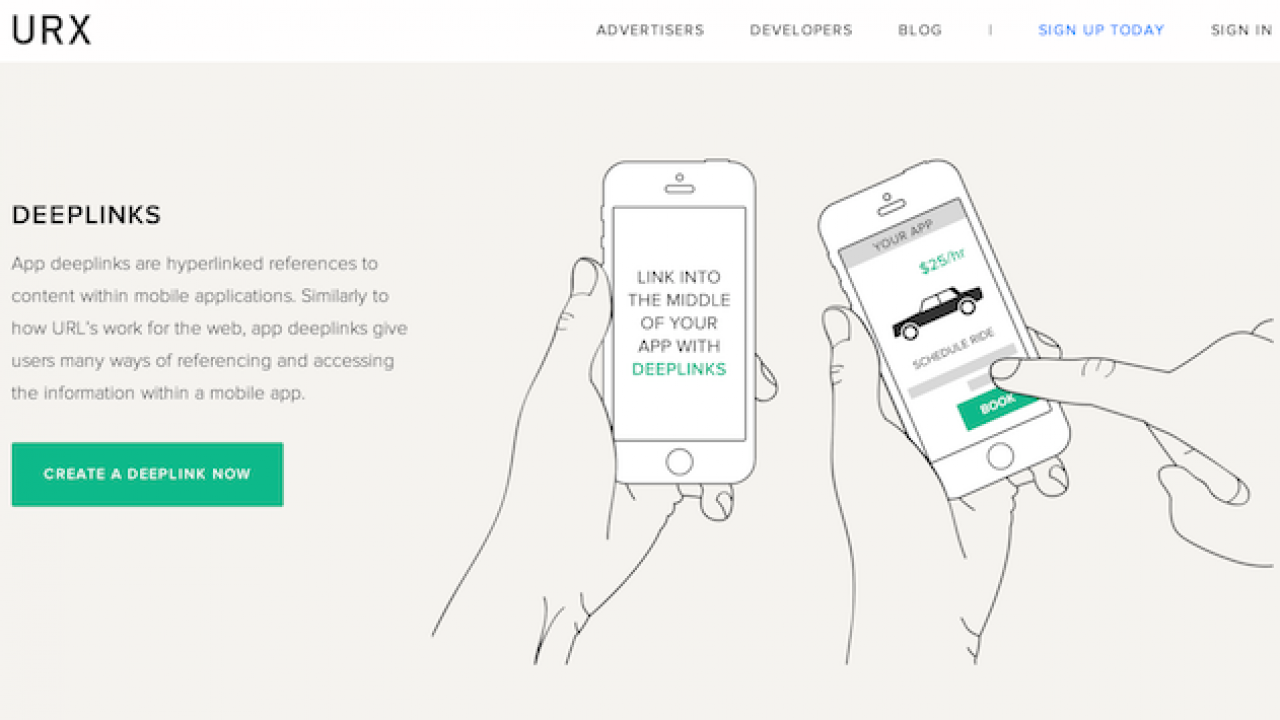URX is Revolutionizing Mobile Ads By Using Something Called Deep Links

If you’ve never heard of deep linking, then I’m sure you’ve experienced the frustration of an app that doesn’t have deep linking. Let me give you a familiar example: LinkedIn sends you an email about a new connection, you click on the link on your mobile device, but instead of directing you to the LinkedIn app that’s already installed on your phone, you get sent to LinkedIn’s homepage instead (where you have to re-log in, etc.). While this is annoying and not the most seamless process, it’s even more annoying for mobile advertisers who want potential customers to be taken directly to their product page within their app when they click on an ad.
URX is trying to change this disconnect between ads and apps. The company, which has been around for a little over a year, is working with clients including Living Social, Spotify and ThreadFlip, to make their mobile ads connect users directly to the right page within an app. Because these particular apps have deep link capabilities, URX is able to create ads that link users directly to the correct page within the application and even tailor ads based on their prior browsing behavior.
“Before deep linking, you couldn’t actually create links into apps, you would just have to be able to invest in opening the app to the top of it or install an app,” said CEO John Milinovich. “Deep linking enables the ability to actually take people to specific content within those applications.”
For example, if you’re browsing in the Craigslist app on your phone, you may see an ad for Living Social within the app because URX’s ad technology knows you have the Living Social app installed on your phone. The ad could also display a specific item based on your prior purchases from Living Social.
So why isn’t this technology actively working on every app on your phone right now? Why do you still have to click through a number of links from one app to get to another app that is already on your phone? The reason is because most apps still don’t have deep link capabilities.
“For the top 5,000 apps or so–about 10 percent of apps actually have deep linking enabled,” said Milinovich. “But within the retail sector or within the more advanced apps, I’d say it’s closer to about 25 or 30 percent.”
The number of apps that are adding deep link capabilities is growing aggressively, however, as companies, particularly retailers, realize the importance of connecting mobile applications together so they work more like pages on the web.
“The content that exists within apps on your device is completely opaque to the outside world. Other apps on your phone or even the browser on your phone, have no understanding or no exposure to what that content is or ultimately have access to it,” Milinovich said. “Google said that in 2003, there were over a trillion links that existed between websites, compare that to today, where almost zero links exists between apps.”
Without deep linking, apps are barely connected to each other at all. This not only frustrates user experience, but it also hinders mobile advertising. By enabling deeplinking between apps, particularly for mobile advertisers, it allows users to have higher click through rates and keeps them engaged.
“The average US consumer has 48 apps on their phone, but they only use 8 to 10 every week, so for those other 40 apps, they have to get creative in how they actually engage their users to come back and actually open their applications,” Milinovich said. “For app developers, their primary focus has been getting people to install their apps, the next challenge for app developers is to reengage and get users to come back to their app.”
Major players like Google, Facebook and Twitter have already realized the importance of deeplinking and have launched their own initiatives to incentivize developers to support deeplinking.
Last year, Twitter launched Twitter Cards to make it possible to attach media links to Tweets that link to your content. Facebook has also made it possible to deep link within its native app. But Milinovich, who used to work for Google, is most excited about Google’s app-indexing initiative.
“The one that I’m most excited about is Google is now doing what they are calling app-indexing for Android which is actually enabling them to index the content within apps so it shows up within Google search results.”
I have to say, I am excited about that too. Imagine searching for a restaurant on Google on your Android device and clicking on one of the results in OpenTable where it automatically takes you to that specific point of the app to book that restaurant because you have OpenTable on your phone….ah, seamlessly connected with one click.